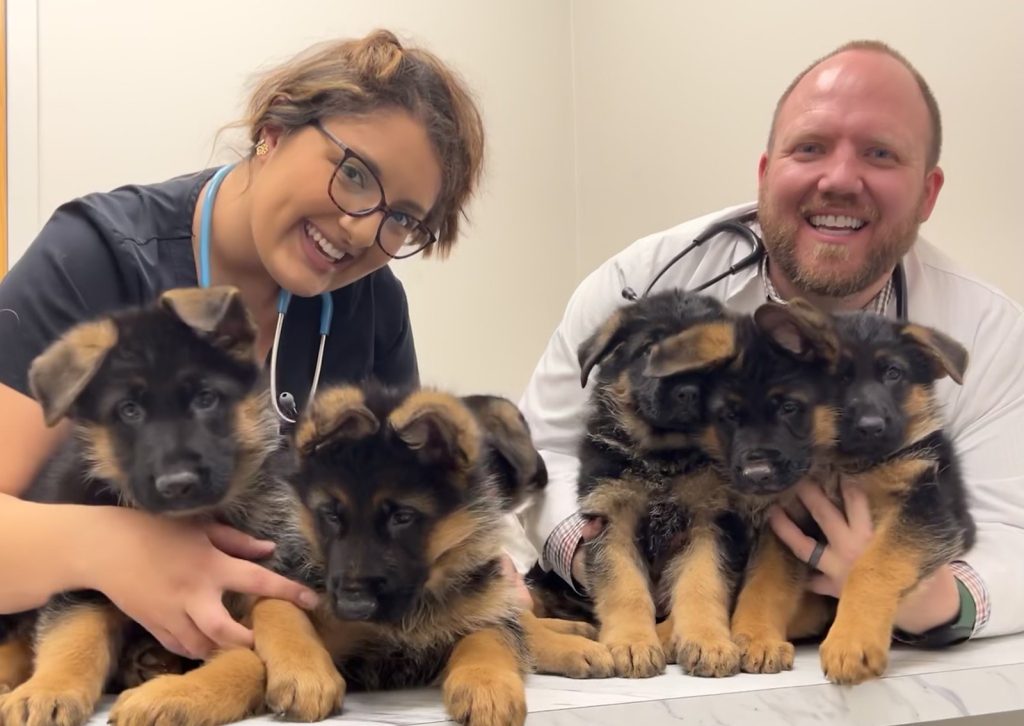How German Shepherd Life Expectancy Became The Hottest Trend Of 2024
페이지 정보

본문
 Health Issues That Affect German Shepherd Life Expectancy
Health Issues That Affect German Shepherd Life ExpectancyGerman Shepherds are at their peak between 2 and 6. They're at their peak in terms of physical fitness and mental toughness.
Their size makes them at a higher risk of developing cancer muscle and joint issues, and other health conditions that may have a negative impact on their lives.
German Shepherds of the working line typically lead more active lives than their show line counterparts. They require a diet that is rich in nutrients to help them maintain their active lifestyles and exercise.
Cushing's Disease
German Shepherds are prone to various health issues, including hip dysplasia, elbow dysplasia, degenerative myelopathy and Cushing's disease. Understanding these ailments and taking the appropriate steps to prevent or treat them can allow your dog to live longer. Regular visits to the vet, good diet and regular exercise will keep this large breed in good health.
Cushing's disease (hyperadrenocorticism) occurs when a pet's body produces too much cortisol, a natural steroid. A tumor on the pituitary or adrenal glands is the most frequent reason for the condition. In 80 to 85% of cases, the tumor occurs on the pituitary, which is a small organ that is located close to the base of the brain. Around 15 percent of the instances the tumor is located on the adrenal glands which are located above the kidneys.
Cushing's disease can cause pets to be more active and consume more food than normal. The condition can also cause more thirst and increased urination. This means that the pet has to drink more water and schäferhund welpen kaufen schweiz baby schäferhunde kaufen (simply click the following webpage) also go outside for frequent breaks to urinate. Other symptoms of the condition include loss of hair, a potbellied appearance, and a lack of energy.
A veterinarian can diagnose the condition by drawing blood and performing an adrenocorticotropic hormonal stimulation test. This test involves injecting ACTH into the patient and then measuring their adrenal response. The results will show how high or low his cortisol levels are.
If a dog is diagnosed with Cushing's, they will require medication for the remainder of his life. The medication will manage the symptoms and slow the growth of the tumor. If they are monitored properly and treated, the majority of dogs suffering from this condition have normal lives. However, the condition could be fatal if not treated and diagnosed early.
Epilepsy
German Shepherds that are diagnosed and treated for epilepsy could be healthy and enjoy a full and happy life. However, a dog that suffers from uncontrolled seizures may die due to oxygen starvation or a traumatic injury that occurs during seizures. Epilepsy that is not treated properly can lead to depression, or the inability to eat or drink.
The effects of epilepsy on German Shepherds can be affected by the way in which the condition is handled by the owner. The owners who are able to closely monitor their dog's medication, and develop seizure management techniques and create a strong network of support will be more likely to prolong their pet's lifespan.
As with all breeds of dog, German Shepherds are prone to suffering from dental diseases. If left untreated, this issue can cause severe damage to gums and teeth and even cause infection in other parts of the body, schäferhund Abzugeben including the liver, kidneys, and the heart. Dogs who receive regular professional dental treatment are less susceptible to this problem.
The deep chests of the Shepherd breed make them more susceptible to bloat. This dangerous stomach disorder occurs when the intestines turn and expand with gas, causing a cutoff in blood flow to the stomach and spleen. This condition could be fatal in as little as 30 minutes if not treated immediately. If your Shepherd exhibits signs of bloat, such as retching or heaving with little or no food coming up or an overly large stomach, or lying in a prayer posture (front feet down and the rear end up), take them to the emergency vet right away.
German Shepherds who suffer from the condition of bloat are more at risk of developing hip dysplasia or degenerative myelopathy. This is why it's important to keep your dog up to date with veterinary visits and preventative treatments.
Elbow Dysplasia
The elbow is a hinge joint between the humerus (the long bone of the upper forelimb) as well as the radius and ulna (the two bones that make up the lower forelimb). The three bones need to be perfectly aligned for a lifetime of movement. If they don't, a condition referred to as elbow dysplasia can develop. It's the leading cause of lameness in the front legs (limping) in dogs.
In some instances of the disease the cartilage between bones begins to degrade, causing pain, swelling, and lameness. The damage is not irreparable, so early diagnosis and treatment are important.
The first indications of the disease in a dog are a slight or intermittent limp, particularly following exercise or upon getting up from a resting position. As the disease progresses the dog's elbow's range of motion decreases. There could also be fluid in the joint.
There are three major types of elbow dysplasia. Fragmented Coronoid Process, Osteochondrosis of the Humeral Condyle, and Ununited Anconeal Process. Each of these conditions can be seen on both elbows or one of them.
Screening for elbows and hips of breeding animals is the best bet to prevent these issues. These conditions can still develop even after screening. The most effective method is to only breed dogs from parents that are found to have good elbows. This will prevent the genes for elbow dysplasia from being passed to offspring.
Degenerative Myelopathy
Degenerative Myelopathy is an illness of the nervous system that affects German Shepherd dogs slowly and causes weakness in the hind legs, is a variant of Degenerative Myelopathy. The signs of DM usually manifest in older dogs, and then develop into paralysis. The condition is considered the canine equivalent of amyotrophic lateral sclerosis (Lou Gehrig's disease). It isn't known why some dogs with this condition develop it, while others don't despite being genetically predisposed.
Unfortunately, there is no cure for DM. The symptoms can be treated by medication, but the disease progresses and eventually causes paralysis of the forelimbs as well. Some dogs are able to endure for months or years with a good quality of life, however it is typical for owners to choose euthanasia once the dog becomes in a position where they are unable to walk or stand on their own.
To diagnose DM to diagnose it, your doctor will conduct a thorough medical history and perform an examination of the neurological system. The neurologist will look for other diseases that have similar clinical signs, and asks for blood samples to examine the genetic mutation that causes with this condition. A cerebrospinal fluid sample may also be taken to permit analysis and exclude other diseases. The neurologist will likely recommend MRI imaging using our advanced diagnostic imaging services. This will allow your vet to identify the regions of the spinal cord that are affected by DM and track the progression of the disease over time. Physical rehabilitation therapy may be beneficial for DM sufferers and can slow the progression of the condition.
Intervertebral Disc Disease
German Shepherds can be prone to health problems that can reduce their life expectancy. Recognizing these conditions and understanding the ways they impact your dog will aid you in taking preventative steps that supports their longevity.
Intervertebral Disc Disease occurs when the "doughnut" of the spinal disc fails to stay in its proper place. Each disk has an outer fibrous ring called an annulus and a soft nucleus that absorbs impacts. If the nucleus becomes herniated, it can cause severe pain and even paralysis. IVDD is a degenerative disease However, sudden traumas can trigger herniation.
Type I of IVDD is associated with the sudden insertion of the disc's nucleus into the spinal canal. It causes intense pain, back pain and back arching, weakness in the rear limbs and hind-limb lameness. It can be accompanied by weakness, incontinence, and incoordination. If the spinal cord is compressed and dies the dog will be completely paralyzed and often not able to use their rear legs even.
Type II IVDD typically occurs in older dogs. It's the result of normal "wear and tear" which results in the weakened annulus fibers swelling with fluid, leading to herniation and compression of the spinal cord. This type of IVDD is not triggered either by trauma or heavy exercise, unlike Type I. It is characterized by a refusal to turn the head, an arched back, and an appearance of weak or wobbly on the rear legs.

- 이전글Choosing Indian Police Uniform Ranks Is Simple 25.01.23
- 다음글Attorneys Accidents Techniques To Simplify Your Daily Life Attorneys Accidents Trick Every Person Should Know 25.01.23
댓글목록
등록된 댓글이 없습니다.

